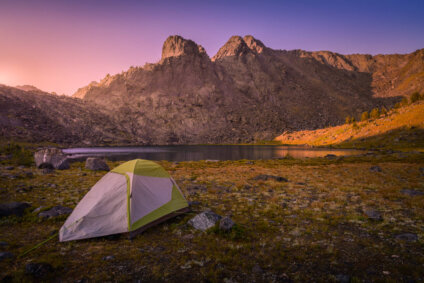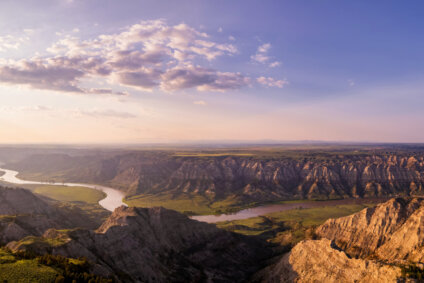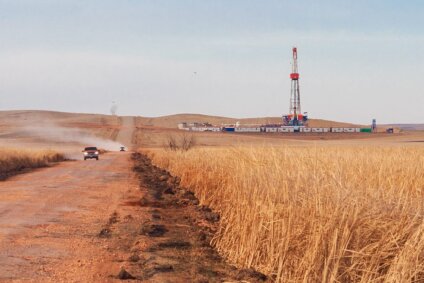Protecting Montana’s Sagebrush Ecosystems
BLM releases draft plan for managing greater sage-grouse across the West, including wildlife habitat in north-central and southwest Montana.

In March, the Bureau of Land Management released a draft plan to update greater sage-grouse management across 10 western states, including Montana. The draft plan incorporates new sage-grouse conservation science, providing an opportunity to protect Montana’s sagebrush ecosystems and the wildlife and communities that depend on them.
A symbol of ecosystem health
Much like the proverbial canary in the coal mine, this iconic bird is considered a keystone species whose health is indicative of the resiliency of the greater sagebrush ecosystem. Healthy sagebrush – the silver-green leafed shrubby plants whose presence defines a large portion of the American West – helps a variety of other plants grow and supports wildlife diversity and abundance. Healthy sagebrush country provides vital habitat to more than 350 species of conservation concern and sustains the water supply, economies, and culture of western communities. Sage-grouse are uniquely dependent on this plant, using it as nesting cover and a year-round food source. The bird’s famous mating dances only occur in open spaces between healthy tracts of sagebrush.
For decades, sage-grouse populations have been in decline, primarily due to habitat loss as roads, fossil fuel development, overhead powerlines, and residential subdivisions degrade and dissect intact sagebrush ecosystems. A recent report from the U.S. Geological Survey found that just 14% of sagebrush ecosystems in the U.S. remain intact and face a variety of threats, including oil and gas drilling and invasive weeds. Every year, the West loses 1.3 million acres of its iconic sagebrush steppe. Sage-grouse now occupy only 56% of its historical habitat. The decline of the sage-grouse underscores the urgent need for strong conservation measures.
Just 14% of sagebrush ecosystems in the U.S. remain intact and face a variety of threats, including oil and gas drilling and invasive weeds.
Source: U.S. Geological Survey report
Conservation efforts and challenges
In Montana, federal and state managers have undertaken substantial efforts to restore sage-grouse habitat and conserve sagebrush seas. In 2015, the U.S. Fish and Wildlife Service determined that greater sage-grouse did not warrant listing under the Endangered Species Act due to the habitat management plans the BLM adopted in consultation and cooperation with states, which are primarily responsible for managing wildlife. As a result of a significant stakeholder process and Gov. Bullock’s Greater Sage Grouse Conservation Advisory Council, the Montana Legislature passed the Greater Sage Grouse Stewardship Act. The act implemented the Montana Sage Grouse Conservation Strategy, which has guided the State’s management approach over the past decade, working in conjunction with largely consistent measures in regional BLM resource management plans across the state.
Despite years of attention from tribal, state, and federal agencies, grouse populations and habitats continue to decline across the West. Between 1966 and 2021, the U.S. Geological Survey tracked an astounding 80% decline in sage-grouse populations, which plummeted another 40% between 2002 and 2021. The continued decline of sage-grouse populations across the West, new scientific information, and changing conditions accelerated by the effects of climate change have prompted the BLM to initiate a review of habitat management plans. This process will amend the RMPs of over 70 field offices in the West, including the Miles City, Hi-Line, Lewistown, Dillon, Butte, Billings, and Upper Missouri River Breaks National Monument RMPs in Montana.
What the BLM is proposing
The BLM’s draft plan includes a range of six alternatives that offer differing goals, objectives, and prescriptions to restore and maintain sagebrush landscape health on BLM lands across the West while balancing other public land uses like grazing, recreation, and energy development. The agency included alternative management tactics to provide flexibility for local decision-makers to respond to local needs while also ensuring consistency in management across the agency’s state offices. The plan is informed by the latest science on sage-grouse populations, climate change, and ongoing state and tribal coordination.
Wild Montana knows that what’s good for the bird is good for the herd: this planning effort is critical to the survival of the sage-grouse, our iconic open spaces, and the wide range of other plants and animals that make their home in the sagebrush sea.
Now is the time for the BLM to use all its available tools to halt habitat destruction and fragmentation. We’re asking the BLM to:
- Retain the special designation of the 980,000-acre Sage Grouse Focal Area north of the Charles M. Russell Wildlife Refuge. The USFWS identified the area as a stronghold for greater sage-grouse, having the highest densities of sage-grouse and other criteria important for the persistence of the species. Maintaining the designation means that the area continues to be excluded from future mining claims with a process called a “mineral withdrawal.”
- Designate the South Valley Phillips Area of Critical Environmental Concern (ACEC) to protect the high-quality habitat and resident sage-grouse populations.
- Designate the Carter Crook Greater Sage Grouse Connectivity Proposed ACEC along the Wyoming border to facilitate genetic connectivity between the northern and southern populations in this landscape where habitat corridors are constricted by extraction activities.
- Close all ACECs to future oil and gas leasing because any fossil fuel development in these special areas will undermine efforts to maintain and improve healthy sagebrush habitat.
- Prohibit speculative and wasteful oil and gas leasing within the Missouri Headwaters Southwest Montana Restoration Landscape, an area with little to no fossil fuel reserves, to ensure that fish and wildlife values throughout this area receive the protection they need and deserve.
Take Action
The urgent need for conservation measures to counter the threats facing the sagebrush landscape is clear. Speak up to help conserve habitat for hundreds of wildlife species and support the livelihoods and traditions of Montana’s communities that rely on healthy public lands.
Submit a comment to the BLM today. We’ve provided you with a draft comment that we encourage you to personalize using our public comment writing guidelines. The deadline to submit your comment is Thursday, June 13, so don’t wait to make your voice heard.
Speak up to protect Montana's sagebrush habitat
Submit a comment to the BLM today asking them to prioritize conservation measures to counter threats to Montana’s iconic sagebrush ecosystems. We’ve provided you with a draft comment that we encourage you to personalize. The deadline to submit your comment is Thursday, June 13, so don’t wait to make your voice heard.

Stay Connected
"(Required)" indicates required fields


